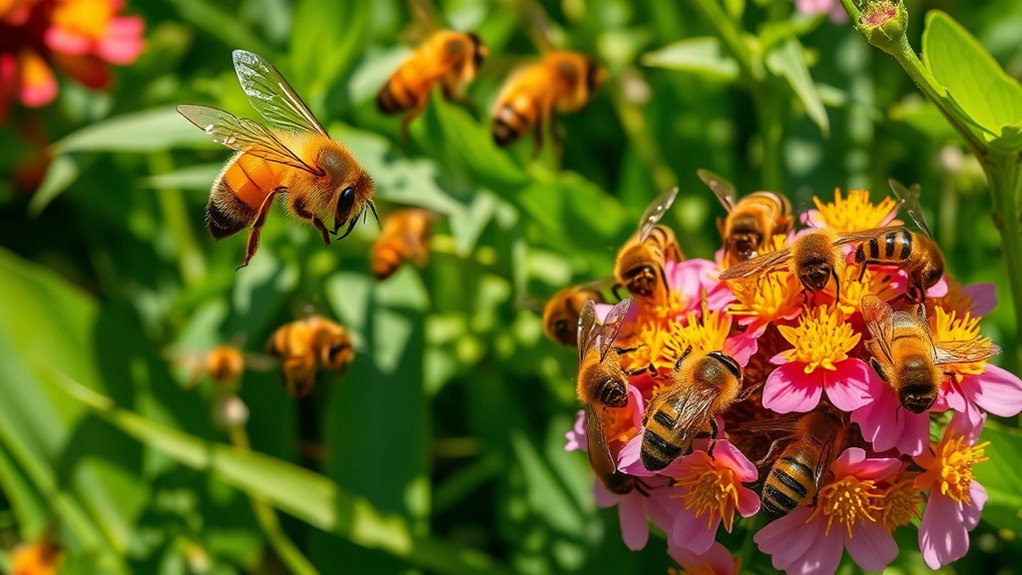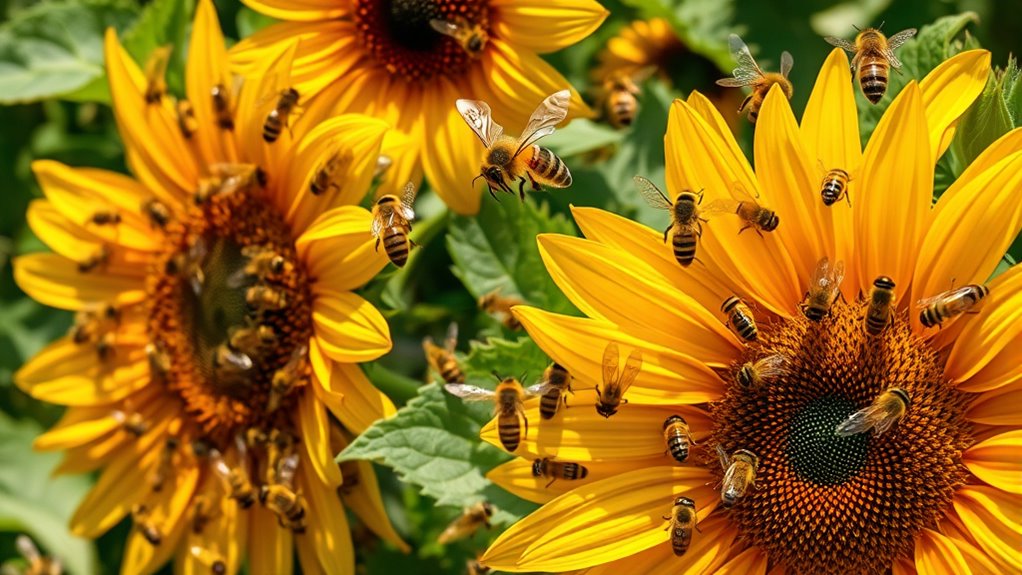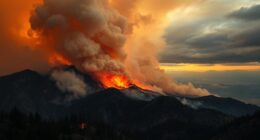Honeybees play a major role in American agriculture, but they often outcompete native bees for floral resources, which can lead to declines in native bee diversity and disrupt ecosystems. While honey bees focus on heavily blooming plants, native bees pollinate many unique and native plants, maintaining ecosystem health. This competition and the potential spread of diseases threaten native pollinators even more. If you want to understand how native bees contribute to resilient ecosystems and how to support them, keep exploring.
Key Takeaways
- Honey bees dominate floral resources in the U.S., often outcompeting native bees and reducing their populations.
- Native bees are vital for pollinating diverse native plants and maintaining ecosystem health.
- Honey bee activity can negatively impact native bee diversity through resource depletion and disease transmission.
- Native bees tend to be more specialized, pollinating plants that honey bees often overlook.
- Conservation efforts focus on protecting native habitats and reducing honey bee dominance to sustain native pollinator diversity.
The Growing Role of Honey Bees in Agriculture

Honey bees play an increasingly essential role in agriculture, especially in regions like North America where native bee populations are often insufficient for large-scale crop pollination. With about 2.8 million colonies across the U.S., each housing roughly 30,000 bees, they’re crucial for ensuring crop yields. As extreme generalist foragers, honey bees visit abundant floral resources more than native bees do, often dominating pollination activities. They tend to focus on high-flower-density plants, effectively supporting crops like almonds, apples, and berries. Their ability to forage over large areas—up to five miles—allows them to pollinate extensive farmland efficiently. Despite being non-native, honey bees are indispensable for modern agriculture, filling gaps left by native pollinator shortages and helping farmers meet food production demands.
Competition for Floral Resources: Who Gets There First?

When it comes to floral resources, honey bees often arrive first and dominate the scene. Their large foraging ranges and high abundance allow them to quickly access and exploit abundant flowers. Honey bees tend to visit the most plentiful floral patches, often outnumbering native bees considerably. This dominance can deplete nectar and pollen, leaving fewer resources for native species that arrive later. Because honey bees are generalist foragers, they focus on high-reward plants, sometimes neglecting native or less competitive species. Their monopolization reduces the diversity of native bee visits and can hinder native plants’ reproduction. Over time, this resource competition can lead to declines in native bee populations, especially smaller species that rely on limited floral resources for survival and reproduction.
How Honey Bees Impact Native Bee Diversity

When honey bees dominate floral resources, native bee diversity often declines because they struggle to compete for the same food sources. This shift can change bee communities, leading to fewer native species and altered ecosystem dynamics. Understanding how honey bees influence native bee populations helps us find better ways to protect these essential pollinators. Additionally, promoting native plantings can support diverse bee populations and reduce competition for resources. Implementing pollinator-friendly landscapes further enhances habitat availability for native bees, encouraging their resilience and diversity. Recognizing the importance of vetted security systems can also help safeguard these vital habitats from intruders and threats. Incorporating positive thinking techniques into conservation efforts can foster a proactive mindset essential for addressing ecological challenges and supporting pollinator health.
Competition for Floral Resources
The presence of large managed honey bee colonies intensifies competition for floral resources, often at the expense of native bees. As honey bees forage over wide areas, they can monopolize abundant flowers, leaving less for native species. This competition impacts native bee diversity and abundance, especially for small wild bees. You might notice:
- Honey bees consume pollen and nectar in huge quantities, reducing availability for native bees.
- Their extensive foraging range allows them to deplete resources across landscapes.
- They favor certain plant species, sometimes neglecting native plants and altering local plant pollination dynamics.
- Implementing vertical storage solutions and creating designated zones can help mitigate habitat disturbances that favor honey bees over native pollinators.
- Understanding the pollination ecology of native bees is crucial for developing effective conservation strategies.
- Additionally, the dominance of honey bees can lead to competitive exclusion, where native species are unable to establish or persist in their natural habitats.
- The high density of honey bee hives in certain areas can also lead to habitat fragmentation, further challenging native bee populations.
- Conservation efforts that incorporate native plant restoration can provide alternative resources and habitats for native bees, helping to sustain their populations.
Such resource depletion can cause declines in native bee populations, weaken ecosystem resilience, and shift plant-pollinator interactions. Managing honey bee densities and protecting native plant habitats are essential to maintaining native bee diversity.
Native Bee Declines
Active managed honey bee colonies markedly contribute to declines in native bee diversity by monopolizing floral resources across landscapes. When honey bees dominate flowering plants, native bees struggle to access enough nectar and pollen, especially smaller wild species. This competition leads to reduced native bee abundance and diversity, with some species becoming scarce or disappearing altogether. Removing honey bees often allows native populations to rebound, but dominant native species may still remain low. Additionally, honey bees’ extensive foraging range can deplete resources over large areas, intensifying pressures on native bees. The presence of honey bees also disrupts native plant pollination, further impacting native bee habitats. Moreover, the high foraging activity of honey bees can alter plant-pollinator interactions, influencing the structure of native ecosystems. Overall, honey bee proliferation poses significant challenges to maintaining healthy, diverse native bee communities essential for resilient ecosystems.
Changing Bee Communities
The dominance of honey bees in floral landscapes markedly alters native bee communities by shifting species composition and abundance. You might notice fewer small wild bees, as honey bees monopolize flowers, reducing resources for native species. This competition can lead to species displacement, making it harder for native bees to thrive. This can lead to:
- Decreased species richness among small native bees due to competition.
- Increased phylogenetic diversity, as dominant native species decline.
- Altered plant-pollinator interactions, with honey bees favoring abundant or weedy plants over native flora.
- The high prevalence of honey bees in certain regions can also impact local divorce statistics, reflecting how regional factors influence community dynamics.
Furthermore, the presence of honey bees often modifies pollination networks, which can have cascading effects on plant reproduction and ecosystem health. These changes are influenced by the bee community dynamics, where the introduction and dominance of honey bees can suppress native bee populations. As honey bees outcompete native bees for nectar and pollen, some native species struggle to survive. Managing honey bee density and preserving native habitats are essential to maintaining healthy, diverse bee communities. Additionally, introducing native bee conservation initiatives can help mitigate these impacts and support ecosystem resilience.
The Hidden Costs of Honey Bee Dominance

When honey bees dominate floral resources, native bees often struggle to find enough food. This intense competition leads to a decline in native bee diversity and shifts the balance of local ecosystems. As honey bee numbers grow, the impact on native species becomes even more significant, revealing hidden ecological costs. Implementing air purification in urban environments can help improve air quality for both humans and wildlife, indirectly supporting healthier ecosystems.
Resource Competition Escalates
Resource competition intensifies as honey bees monopolize floral resources across landscapes, often at the expense of native bees. When honey bees dominate, native species struggle to find enough nectar and pollen to survive and reproduce. This increased competition can lead to declines in native bee diversity and abundance. You might notice:
- Small wild bees experience sharper decreases in species richness as honey bee numbers grow.
- Honey bees’ wide foraging range allows them to deplete resources over large areas, leaving less for native bees.
- Native plants and flowers get less pollinated as honey bees focus on certain abundant species, impacting native plant reproduction.
- The dominance of honey bees can also alter pollination dynamics, affecting the health of entire ecosystems.
This fierce competition not only reduces native bee populations but also weakens the resilience of local ecosystems, making native pollinators even more vulnerable.
Native Diversity Declines
As honey bees dominate floral resources across landscapes, native bee diversity often declines silently and without obvious warning. You might notice fewer native species in areas with high honey bee activity, especially small wild bees that rely on limited floral resources. Honey bees outcompete native bees for nectar and pollen, monopolizing abundant flowers over large areas. This resource depletion reduces native bees’ reproductive success and species richness, leading to fewer native varieties over time. While some native species may rebound if honey bee numbers decrease, others remain suppressed. The dominance of honey bees also shifts the phylogenetic diversity, favoring certain resilient native species. Additionally, research indicates that pollinator competition can significantly impact native bee populations and their ecological roles. This competition can alter pollination networks, threatening the stability of local ecosystems. Overall, honey bee proliferation threatens the intricate balance of native bee communities, jeopardizing the ecological functions they support.
Disease Risks and Cross-Species Transmission

The presence of managed honey bee colonies poses a significant risk of transmitting diseases and parasites to native bee populations. When honey bees carry pathogens, they can spread them through shared floral resources or direct contact, harming native species. You should be aware that:
- Cross-species pathogen transfer increases stress and declines in native bee health.
- Diseases like deformed wing virus and nosema can jump from honey bees to native bees, weakening their immune systems.
- Managing honey bee health is vital to prevent outbreaks that threaten local native pollinator populations.
- Understanding disease transmission is crucial for developing effective conservation strategies to protect native pollinators.
- Implementing hive health management practices can reduce the risk of pathogen spillover between species.
- Additionally, tuning beekeeping practices to minimize pathogen spread can play a significant role in safeguarding native bees.
- Monitoring pathogen prevalence in both managed and wild bee populations can help identify emerging threats before they escalate.
- It is also important to consider how environmental factors such as habitat loss and pesticide use can exacerbate disease impacts on native bees.
These disease transmissions complicate conservation efforts and threaten biodiversity. Because native bees often have limited defenses, the spread of pathogens from honey bees can accelerate native bee declines, impacting ecosystems and pollination services you rely on.
Native Bees: Unsung Heroes of Pollination

Native bees often go unnoticed despite their essential role in pollination, supporting ecosystems and agriculture alike. You might not realize that over 80% of flowering plants worldwide rely on native bees for reproduction. Unlike honey bees, native bees include a diverse range of species, from tiny sweat bees to large bumblebees, each adapted to specific plants and habitats. They often pollinate plants that honey bees overlook, ensuring plant diversity and ecosystem health. Native bees are more efficient per visit at pollinating certain flowers, which helps maintain resilient pollination networks. Despite their importance, many native bee populations are declining due to habitat loss, disease, and competition from honey bees. Protecting and restoring native bee habitats is essential for sustaining their vital contributions to food production and biodiversity. Implementing native bee conservation efforts can help ensure these invaluable pollinators continue to thrive.
Strategies for Supporting Native Pollinator Populations

Supporting native pollinator populations requires targeted actions that address their specific needs and challenges. You can do this by creating habitats that provide native plants, which offer essential pollen and nectar sources. Limiting pesticide use protects these fragile communities from harmful chemicals. Additionally, fostering community awareness helps promote native bee-friendly practices.
Consider these strategies:
- Plant diverse native flowering species to ensure year-round food sources.
- Reduce or eliminate pesticide application, especially during peak pollination periods.
- Support local conservation projects focused on native bee habitat restoration.
Frequently Asked Questions
How Do Native Bees and Honey Bees Compete for Floral Resources?
You notice that honey bees and native bees compete for floral resources by actively foraging on the same plants. Honey bees, with their wide foraging range, monopolize abundant flowers, often outnumbering native insects. They prefer certain plants, which can deplete nectar and pollen, leaving less for native bees. This competition can reduce native bee diversity and affect native plant pollination, especially when honey bees dominate large areas.
What Are the Long-Term Effects of Honey Bee Dominance on Native Bee Populations?
You’ll see native bee populations decline over the long term because honey bees dominate floral resources, outcompeting native species for pollen and nectar. This reduces native bee diversity, especially among small wild bees, and can lead to decreased resilience in pollination networks. Additionally, disease transmission from honey bees adds stress to native populations. Ultimately, unchecked honey bee dominance risks disrupting native ecosystems and diminishing native bees’ essential ecological roles.
Can Native Bees Replace Honey Bees in Commercial Pollination?
Native bees can’t fully substitute honey bees in commercial pollination. Their smaller size, limited foraging range, and lower population densities hinder large-scale crop coverage. While native bees excel in native plant pollination and ecosystem resilience, honey bees’ adaptability and extensive colonies make them essential for mass agriculture. You need a balance—support native habitats while managing honey bee impacts—to ensure both native bee diversity and agricultural productivity thrive together.
How Does Honey Bee Disease Transmission Affect Native Bee Health?
You should know that honey bee disease transmission can seriously harm native bee health. When managed colonies carry pathogens or parasites, these can spread to wild bees, increasing their stress and vulnerability. This cross-infection weakens native populations, reduces their reproductive success, and hampers their ability to survive. To protect native bees, it’s essential to manage honey bee health carefully and limit disease spread through good practices and monitoring.
What Conservation Strategies Effectively Support Native Bee Diversity?
Think of native bee conservation as tending a delicate garden—you need to protect and nurture their habitat first. You can do this by planting native flowers, reducing pesticide use, and creating safe nesting sites. Limiting honey bee colony densities in sensitive areas also helps prevent competition and disease spread. Stay informed through citizen science programs to support policies that prioritize native bee health, ensuring these essential pollinators thrive like a well-tended garden.
Conclusion
To truly protect America’s pollinators, you need to understand the delicate balance between honeybees and native bees. While honeybees are essential for agriculture, they shouldn’t overshadow native species that have unique roles. By supporting native pollinator habitats and reducing competition, you can help guarantee they thrive. Remember, you can’t have your cake and eat it too—taking care of native bees benefits the entire ecosystem, so it’s worth the effort.








